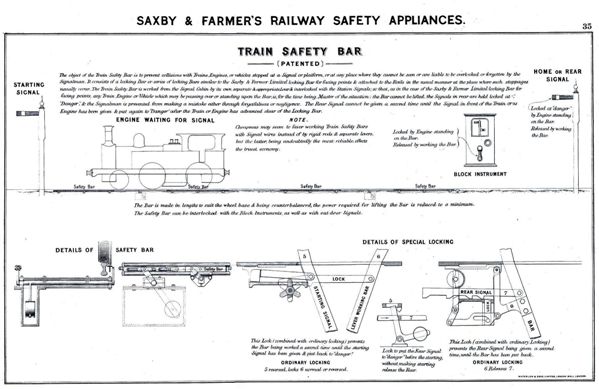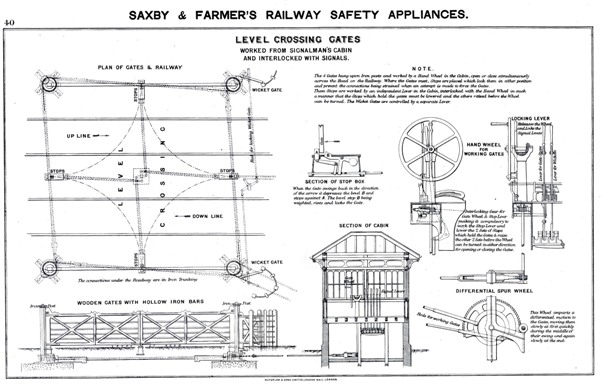IMPROVED TELEGRAPHIC BLOCK INSTRUMENTS, INDICATORS,
BELLS & C.

TRAIN SAFETY BAR

THE
ELECTRIC SLOT SIGNAL
(FARMER
& TYER'S PATENT.)
This Invention is named "Electric Slot" because it has the same objects,
and obtains the same advantages, as are obtained by the beautifully simple
and most useful invention known as the Mechanical Slot," with this difference,
that whereas mechanical means of working by rod or wire are necessarily limited
to the distance at which those means are available, the electric means of
working are altogether irrespective of distance.
The advantages common to both inventions, viz., the "Mechanical" and "Electric
Slot" are, that One and the same out-door signal can be worked and controlled
by two or more signalmen stationed at places apart from each other.
Each signalman has the power of placing and holding the signal at the "danger"
attitude independently of any action on the part of either of the other signalmen,
and consequently, it is impossible that the signal can be placed in the attitude
indicating " Safety," without the consent and concurrent action of each and
all of the signalmen concerned in the working of it.
The "Electric Slot" is especially advantageous in working the Block System—by
its use the signalman who receives a telegraph indication of "Line Blocked"
from the signalman in advance, cannot possibly give a contrary signal upon
the out-door Semaphore to the Engine Driver,
Electricity has been employed in contrivances for Locking Signal Levers
in their normal positions, i.e. holding the Signal in the "Danger" attitude,
but in the case of the Lever being already pulled over and the Signal being
placed in the "Safety" attitude, those contrivances are powerless to alter
it.
The "Electric Slot" is the only contrivance by which an Out-door Signal
at one Station can be instantaneously changed from the "safety" to the "danger"
attitude from any other station irrespective of distance.
This power of direct and instantaneous action upon the Out-door Signals
at a distant Station might, under certain circumstances of emergency, be
of supreme importance in preventing accidents, or in mitigating their consequences.



LEVEL CROSSING GATES INTERLOCKED
WITH SIGNALS.
This valuable combination insures the safe working of Railway Traffic over
Public Roads and of Public Road Traffic over Railways, at Level Crossings.
The Gates cannot be opened for Road Traffic without the Railway Signals being
FIRST set and securely locked at "Danger," and the Railway Signals cannot
be given to allow Trains to pass until the Gates have been first closed and
securely locked against the high road. The value of this arrangement for securing
the safety of the public travelling by road or rail, at Level Crossings, is
meeting due recognition as it becomes known. As a question of economy, also,
the system is much appreciated by those Railway Companies who have tried
it.
IMPORTANT NOTE AS TO GATE "STOPS."
The Gate'Stops' although a not inconsiderable addition to the cost are essential
to completeness and thorough efficiency. They prevent the Gates from being
moved when in their proper position by any one except the Signalman; they
are made to rise out of the ground and fall below the ground by the movement
of a separate lever interlocked with the Signals, and also interlocked with
the wheel or lever which works the Gates in such a way that the wheel or lever
cannot be moved till the stop lever has been first moved.
The stops are self-acting in one direction, being shelving on one side and
perpendicular on the other side, so that the Gates, as they swing, encounter
the shelving sides of the stops which give way downwards and allow the Gates
to pass over them, but prevent the Gates from being moved back again till
the stops are lowered by the stop lever.
The opening of the Gates for highway traffic must, of necessity, be PRECEDED
by the lowering of the highway stops, which are, therefore, securely put out
of the way of becoming a stumbling-block to foot passengers, horses, &c.
The thorough completeness and efficiency of these arrangements, including
the stops, four of which are required, as shown on the opposite page, and
the substantial character of all the work and parts should be considered in
attempting any comparison of cost as against prices quoted for Gates that
have no pretensions to any such qualities and are not provided with stops.

Interlocking
Union of Lock and Block
Saxby & Farmer page
Startsidan
Sidan uppdaterad den 18 augusti 2013